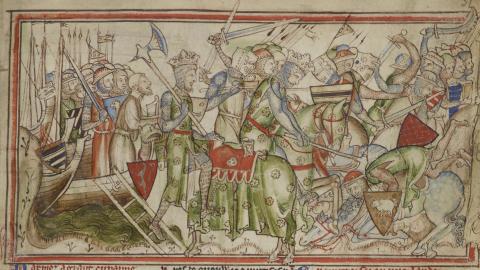
The Stuarts: Britain's unluckiest royal dynasty
Calling the Stuarts the 'Doomed Dynasty' might be going a little too far, but they definitely had a rough go of it. Especially considering that even one of their more successful monarchs, Charles II, spent almost a decade in exile.
Image: Charles I | Public Domain
The Stuart dynasty began with Robert II of Scotland in 1371. During the next 370 turbulent years, the bloodline suffered disasters including the murder of one Stuart monarch, the execution of two others for treason and several Scottish kings dying while fighting in battle. The last of the Stuart claims for the throne ended with Bonnie Prince Charlie who, defeated at the Battle of Culloden in 1746, left Scottish soil for exile in Europe.
James I
James was captured by the English in 1406 and held hostage for 18 years until he was ransomed. During James’s absence, the Duke of Albany and later his own son Murdoch held power as regents, and the great nobles built up power and independence.
Once James was restored to power, his vindictive policies made him greatly unpopular and he was assassinated on the orders of his uncle, Walter, Earl of Atholl. The king was in a monastery in Perth when he was attacked by a group of assailants. He managed to flee but was eventually trapped in a sewer and stabbed to death.
James II
James II assumed control of the Scottish Crown in 1449 after he quelled disruption in the country from troublesome nobility. The most threatening of all clans was the powerful Clan Douglas who wielded power behind the Stuart kings. The Douglas leaders were invited to dinner with the young king in 1440 at Stirling Castle, where they were subjected to a mock trial and beheaded in the courtyard.
James’s own violent fate occurred while besieging Roxburgh Castle which was held by the English during the Wars of the Roses. He hoped to claim Roxburgh and Berwick for Scotland but was killed by an exploding gun.
James III
The unpopular and ineffective James III took the Crown in 1469. More of a scholar than a soldier, his efforts to assert royal authority eventually provoked rebellions and an English invasion.
Dealing with conspiracies to replace him, including one plot where his own son was set up as king, James confronted the rebels at the Battle of Sauchieburn, two miles south of Stirling in 1488. During the fierce fighting, he was thrown from his horse. Although hurt, he was able to continue until he was stabbed to death by a man masquerading as a priest.
James IV
Said to be a born leader, James IV crushed the rebels in Scotland and established his royal authority. Despite his tenure of economic growth, he pursued increasingly tough policies that invited conflict. Despite being married to Henry VIII’s sister and having an alliance with England, James took up assistance with the ‘auld ally’ France. England’s Henry rejected James’s attempts to negotiate peace, seeing Scotland as his domain.
On 22nd August 1513, King James, at the head of the largest army Scotland had produced, crossed the River Tweed into England. The Scots and English armies met near Flodden Edge. Scottish spears were no match for the better-equipped English soldiers and the scene turned into a bloody massacre. Scotland lost the king, nine earls, 14 lords and thousands of soldiers.
Mary Queen of Scots
Instead of an arranged betrothal to Henry VIII’s son, Edward, the infant Mary was sent to France and married the Dauphin, later Francis II. When she returned to Scotland after her husband’s death in 1561, Mary, a stout Catholic was at odds with a mostly Protestant country. From the moment Mary married her unruly cousin Lord Henry Darnley, her life took a disastrous path involving a plot to kill her husband and then scandalising her subjects by marrying her lover, the Earl of Bothwell, accused of carrying out the murder.
After Mary was forced to abdicate, she fled to England expecting her cousin, Elizabeth I, to assist and restore her position as Queen of Scotland. Elizabeth, aware of Mary’s potential to usurp her, had the Scottish queen held prisoner. After 19 years of incarceration and remaining a focus for pro-Catholic rebels, Mary was found guilty of a plot against Elizabeth and executed by beheading at Fotheringhay Castle in Northamptonshire. The execution famously recounts Mary’s red dress for martyrdom and the fact that it took several blows to decapitate her.
James VI of Scotland and James I of England
James VI was proclaimed king at the age of one on the forced abdication of his mother, Mary Queen of Scots. He ascended the throne on 24th July 1567 and was crowned at Stirling five days later.
As a child, James was little more than a puppet king ruled by a succession of regents. But in 1583, at the age of 16, he escaped from the clinches of Protestant lords and asserted his authority. James was one of Scotland’s most successful monarchs. He was a shrewd political operator but was caught in the conflicts of civil war. When Queen Elizabeth I died, James inherited the English Crown in 1603, becoming James I of England.
Although famously associated with the Gunpowder Plot of 1605 when Catholic rebels tried to assassinate him in the House of Parliament, he also steered a pernicious campaign of persecuting women accused of witchcraft throughout the country. Married to Anne of Denmark, who produced three sons and five daughters, James’s homosexual inclinations and close relations with dubious men (like one George Villiers) strained the king’s relations at court.
Despite efforts as a peacemaker, James found himself in conflict with Puritans in the Church undermining his vision of unity between England, Scotland and Ireland. One of his most significant legacies was commissioning an authorised version of the Bible. Unlike many of his Stuart predecessors, James I died of natural causes at 58.
Charles I
Charles I was a puny, sickly child and only became king on the death of his elder brother Henry. Famously seeing his position as ordained by God, Charles encountered opposition in parliament when he exercised an autocratic attitude levying unsanctioned taxes, which led to political conflict and a contest between the Crown and parliament.
The king’s attempt to arrest five leading members of the Commons put him on a collision course with one of its most radical members, Oliver Cromwell. Confident of his ‘divine right’ as king and unprepared to compromise, Charles became a disadvantaged royal figure against Cromwell’s parliamentarian army and lost. The decision to execute Charles by the state was an unprecedented event for England and Europe.
He famously wore two shirts on the scaffold in Whitehall, as it was a cold, and he thought if he shivered people would assume he was afraid.
James II
James II was the younger brother of the popular Charles II but failed to endear himself to the public. Although respected as a good soldier and naval commander, his Roman Catholicism was a pressing issue.
When James had a son (James Edward) indicating a Catholic succession, the tide turned for his future as an invite was sent to his Protestant son-in-law, William of Orange, to take the Crown. Even though James did not plan to destroy the Church of England – he merely wanted to restore quality for Catholics - his manner of riding roughshod over opponents made it impossible for him to rule with authority. He fled to France in 1688 and lived his life in exile.
Bonnie Prince Charlie
Grandson of the exiled James II and known as ‘the Young Pretender’, Charles Stuart was also famously nicknamed ‘Bonnie Prince Charlie’. Born in Rome, the extravagantly attired Charles spent his early life in Italy. In 1744, Charles took part in a planned invasion of Scotland to restore the Stuart line. Forced to land on the west coast due to bad weather, he proceeded with the assistance of the Jacobites to lead several successful uprisings including two victories at the Battle of Prestonpans in September 1745 and the Battle of Falkirk Muir in January 1746.
Two months later, the Jacobite cause was finally lost when British forces under Prince William Augustus, Duke of Cumberland defeated Charles’s army at Culloden. The ferocious battle where the Jacobite army was outnumbered resulted in up to 2,000 killed or wounded. The battle effectively ended the Stuart cause to restore the Scottish dynasty to the Crown.
Whether the story about ‘Bonnie Prince Charlie’ having been assisted by a local girl who helped him to escape to France is true or folklore, the fact is that the Young Pretender spent the rest of his days in France and Italy before marrying in 1772. Years later, an alcoholic and in declining health where he needed assistance to move due to swollen legs and ulcers, he died in Rome of a stroke at age 67.























